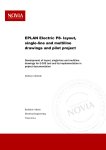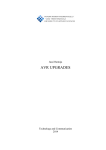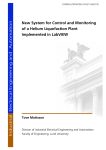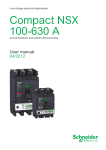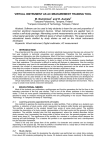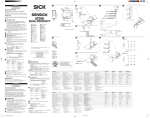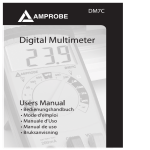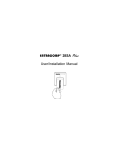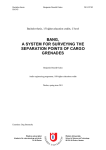Download Dimensioning of electrical installations
Transcript
Dimensioning of electrical installations Calculation softwares examined Mats Lindstedt Bachelor’s thesis Electrical Engineering Vaasa 2011 BACHELOR’S THESIS Author: Mats Lindstedt Degree programme: Electrical Engineering Specialization: Electrical Power Engineering Supervisor: Matts Nickull Title: Dimensioning of electrical installations ____________________________________________________________ Date: 7 Feb 2011 Number of pages: 45 Appendices: 3 ____________________________________________________________ Abstract This thesis is an examination of calculation softwares for the dimensioning of electrical installations. The thesis is done in cooperation with Vaasa Engineering Oy. The goal is to help the employer find a calculation software that is suitable for their needs. First the fundamental theory concerning the subject is dealt with. A short description of how the softwares are utilized in project planning links the theory to a practical usage of calculation softwares. These are presented from the angle of plant calculation procedures. After the presentation the calculation softwares are summarized in an evaluation of benefits and drawbacks. The result is a recommendation of which calculation software the employer should use for dimensioning electrical installations. The thesis is concluded with a short conclusion and discussion. _____________________________________________________________ Language: English Key words: calculation software, electrical installation, Vaasa Engineering Oy _____________________________________________________________ EXAMENSARBETE Författare: Mats Lindstedt Utbildningsprogram och ort: Elektroteknik, Vasa Inriktningsalternativ: Elkraftsteknik Handledare: Matts Nickull Titel: Dimensionering av elanläggningar ____________________________________________________________ Datum: 7 feb 2011 Sidantal: 45 Bilagor: 3 ____________________________________________________________ Abstrakt Detta examensarbete är en undersökning av beräkningsprogram för dimensionering av elanläggningar. Examensarbetet är gjort i samarbete med Vaasa Engineering Oy. Målet är att hjälpa uppdragsgivaren med att hitta ett beräkningsprogram som är lämpligt för deras behov. Först behandlas den grundläggande teorin gällande ämnet. En kort förklaring av hur dessa program kan utnyttjas inom projektplanering länkar teorin till praktisk användning av beräkningsprogram. Dessa program presenteras ur synvinkeln tillvägagångssätt för beräkning av elanläggningar. Efter presentationen sammanfattas beräkningsprogrammen i en utvärdering av för- och nackdelar. Resultatet är en rekommendation av vilket beräkningsprogram uppdragsgivaren borde använda för dimensionering av elanläggningar. Examensarbetet avslutas med en kort sammanfattning samt diskussion. ____________________________________________________________ Språk: engelska Nyckelord: beräkningsprogram, elanläggning, Vaasa Engineering Oy ____________________________________________________________ OPINNÄYTETYÖ Tekijä: Mats Lindstedt Koulutusohjelma ja paikkakunta: Sähkötekniikka Vaasa Suuntautumisvaihtoehto: Sähkövoimatekniikka Ohjaaja: Matts Nickull Nimike: Sähkölaitteistojen mitoitus ____________________________________________________________ Päivämäärä: 7 helm 2011 Sivumäärä: 45 Liitteet: 3 ____________________________________________________________ Tiivistelmä Tämä opinnäytetyö käsittää laskentaohjelmistoja sähkölaitteistojen mitoitusta varten. Opinnäytetyö on tehty ytheistyössä Vaasa Engineering Oy:n kanssa. Tavoitteena on auttaa tehtävän toimeksiantajaa heille sopivan laskentaohjelmiston löytämisessä. Ensiksi on käsitelty aiheeseen liittyvä perusteoria. Lyhyt selitys siitä, miten ohjelmistoja voi käyttää projektisuunnittelussa sitoo teorian käytännölliseen laskentaohjelmistojen käyttöön. Nämä ovat esitetty laitteistojen laskentamenettelytavan näkökulmasta. Ohjelmistojen esittelyn jälkeen niistä on yhteenveto etujen ja haittapuolien arvioinnin laskentaohjelmistoa yhteydessä. Tulos on suositus toimeksiantajan tulisi käyttää siitä, mitä sähkölaitteistojen mitoitukseen. Opinnäytetyön päättää lyhyt yhteenveto ja keskustelu. ___________________________________________________________ Kieli: englanti Avainsanat: laskentaohjelmisto, sähkölaitteisto, Vaasa Engineering Oy ___________________________________________________________ Table of contents 1 2 Introduction ................................................................................................................... 1 2.1 Vaasa Engineering Oy ............................................................................................ 2 2.2 Goal and expectations ............................................................................................. 2 Theory............................................................................................................................ 3 2.1 Types of distribution systems ................................................................................. 3 2.1.1 IT-systems ....................................................................................................... 4 2.1.2 TN-systems ...................................................................................................... 4 2.1.3 TT-systems ...................................................................................................... 5 2.2 Conductor current carrying capacity....................................................................... 5 2.2.1 Conductor overload ......................................................................................... 6 2.2.2 Overload protection ......................................................................................... 6 2.3 Short-circuit currents .............................................................................................. 7 2.3.1 Characteristics of short-circuit currents ........................................................... 7 2.3.2 Protection against contact voltage ................................................................... 8 2.3.3 Protection of cables ......................................................................................... 8 2.4 Calculation of impedances ...................................................................................... 9 2.5 Calculation of short-circuit currents ..................................................................... 11 2.6 The short-circuit power method ............................................................................ 12 2.7 Voltage drop ......................................................................................................... 14 2.8 Selectivity ............................................................................................................. 15 3 Calculation softwares utilized ..................................................................................... 16 4 ABB Doc 1.0.0.0009 ................................................................................................... 18 4.1 4.1.1 General properties.......................................................................................... 19 4.1.2 Selecting layout ............................................................................................. 21 4.1.3 ABB Doc Toolbars ......................................................................................... 21 4.2 5 ABB Doc setup ..................................................................................................... 18 Drawing in ABB Doc ........................................................................................... 23 4.2.1 LV diagram .................................................................................................... 23 4.2.2 Auxiliaries ..................................................................................................... 24 4.2.3 MV diagram ................................................................................................... 25 4.3 Calculation module ............................................................................................... 25 4.4 Curves module ...................................................................................................... 27 4.5 Documentation module ......................................................................................... 28 Febdok 5.0.42 .............................................................................................................. 30 5.1 Febdok setup ......................................................................................................... 30 5.2 Drawing in Febdok ............................................................................................... 32 5.2.1 Febdok toolbar ............................................................................................... 32 5.2.2 Transformer and UPS .................................................................................... 33 5.2.3 The single-line diagram ................................................................................. 34 5.3 2.2.1 I/t menu .......................................................................................................... 35 2.2.2 Comments on calculations ............................................................................. 36 5.4 6 7 Calculation results................................................................................................. 34 Febdok documentation ........................................................................................... 37 Other alternatives ......................................................................................................... 37 6.3.1 My ecodial L.................................................................................................. 37 6.3.2 Calculations in Microsoft excel ..................................................................... 38 Benefits and drawbacks ............................................................................................... 39 7.1 ABB Doc benefits and drawbacks ........................................................................ 39 7.2 Febdok benefits and drawbacks ............................................................................ 40 8 Result ........................................................................................................................... 42 9 Conclusion and discussion .......................................................................................... 43 9.1 Conclusion ............................................................................................................ 43 9.2 Discussion ............................................................................................................. 44 List of sources ...................................................................................................................... 45 Appendices 1. Reference methods of installation 2. Current carrying capacities and correction factors 3. Generator technical specification 1 1 Introduction When planning electrical installations, safety is always the highest priority. The protection requirements as regards humans and animals must be fulfilled in any situation. Electrical faults may also cause fire. This is why electrical installations must be planned and dimensioned correctly to ensure a safe installation for users. The installation should also be reliable and qualitative to guarantee device operations and to prevent failures in sensitive devices. Quality means that disturbances, harmonics and voltage levels should be kept within margins. The protection of humans is primarily done by preventing them from contact with live parts through isolation, enclosure or barriers. However, if these are defective the protection should be fulfilled in other ways. Exposed conductive parts may in some cases also become live due to isolation faults. In fault situations the current must be cut very fast to prevent injuries or fire. Satisfaction of the required demands must be proven through calculation or measurements with an approved instrument. Since measurement cannot be done in advance, calculations should always be done. By making correct calculations, expensive misdimensioning will also be avoided. This thesis deals with calculation softwares for the dimensioning of electrical installations. First some potential programs are looked into on the basis of wishes and advice from the employer and a quick overview of the properties of different programs. In the theory chapter the regulations concerning dimensioning of electrical installations have been studied. The theory is primarily based on the Finnish standardization association’s regulations for low-voltage systems SFS-6000. Most of the information is taken from student literature found in the library, parallel to the SFS-6000. Some comprehensive information is taken from IEC-60909 “short-circuit currents in three-phase AC systems”. Software handbooks also contain very good information on the field. 2 1.1 Vaasa Engineering Oy Vaasa Engineering Oy (often referred to as VEO) provide automation and electrification solutions for the energy sector covering energy production, transmission, distribution and use. They deliver turnkey projects, project components, design and engineering, procurement and supply, project management, installation, start-up, commissioning and user training to customers worldwide. VEO also offer plant modernizations, maintenance, system updates and switchgears. They develop and manufacture all of their core products in-house. As well as their own products VEO also deliver components from leading manufacturers throughout the entire energy field. This helps them to remain at the leading edge of development and to offer optimum, preferred solutions to their customers. (www.veo.fi) 1.2 Goal and expectations Dimensioning electrical installations can sometimes be tough and time consuming, especially in extensive installations that may include several motors, transformers or generators. Those who plan electrical installations must also be able to provide their customers with professional documentation. My employer operates in the power generation, distribution and industrial fields. The electric installations in these kinds of plants are usually very extensive. This makes calculations very challenging. Particular effort is put on reliability, since operation interruptions may become very expensive. This is why the employer has given me the assignment to look into some software tools that will help the project engineers with the calculation of electrical installations. The goal is to find a software tool that is user friendly, rapid to use and versatile. The program should at least be able to calculate short-circuit currents, voltage drops and touch voltages and also to verify selectivity. It is also important that the documentation of calculations is distinct and professional. The pros and cons of some calculation softwares will be evaluated to help the employer decide which tool is most suitable for their needs. This requires some thorough knowledge about the tools in question. 3 My expectations of this assignment are primarily to learn how calculation tools can be utilized in the best possible way in project planning. I also expect to learn more about how each component in electrical installations affects the characteristics of electricity. 2 Theory The dimensioning of cables and over-current protection devices is one of the most important things when planning electrical installations. Load-ability, short-circuit current and voltagedrop are all affected by the conductor dimensions. Conductor cross-section areas and the overcurrent protection devices must be chosen so that fault-protection requirements are met in any situation. Other factors that should be considered are future extensions of the plant and economical aspects. The economical aspects can be purchase and installation costs, or loss and maintenance costs. This chapter contains the fundamental theory of dimensioning electrical installations. It includes explanations of the most vital properties, and calculation procedures of electrical installations. 2.1 Types of distribution systems The dimensioning of distribution systems may at some points differ, depending on the type of system in question. The type of system depends on how live conductors and earthings are realized. In AC-systems there are one, two or three phase conductors and usually one neutral conductor and a protective conductor. The neutral conductor is also considered a live conductor. (Suomen Sähköurakoitsijaliitto ry, 1995, p.52-56) 4 2.1.1 IT-systems In an IT-system no live parts are earthed directly. Exposed conductive parts are connected directly to earth. IT-systems are commonly used as LV-subsystems to increase reliability. (Suomen Sähköurakoitsijaliitto ry, 1995, p.56) Figure.1a. IT AC-system 2.1.2 Figure.1b. IT DC-system TN-systems In a TN system one point is earthed directly and the exposed conductive parts are connected to this point with a protective earthing conductor or PEN-conductor. TN-systems are the most common systems used in power distribution. The TN-system is divided into three different systems depending on neutral and protective earthing conductor mutual arrangements. TN-S has separate neutral and protective earthing conductors in the entire system. In TN-C-S neutral and earthing conductors are combined in parts of the system. In TN-C neutral and earthing conductors are combined in the entire system. (Tiainen, 2008a, p.30-31) Figure.2a. TN AC-system Figure.2b. TN DC-system 5 2.1.3 TT-systems In a TT-system one point is earthed directly. Exposed conductive parts are connected to separate electrically independent earth electrodes. The TT-system is generally not used in distribution. TT-systems are used in special cases such as secondary windings of voltage transformers. (Suomen Sähköurakoitsijaliitto ry, 1995, p.56) Figure.3a.TT AC-system 2.2 Figure.3b.TT DC-system Conductor current carrying capacity Electric currents heat the conductor it flows through because of power losses due to electric resistivity in the conductor. The heat is transferred from the conductor to the surroundings through its insulation and protective layers. Since the cable has a certain heat resistivity, the temperature of the conductor rises until it reaches the point where the transferred heat corresponds to the heat losses in the cable. Larger cross-section area of the conductor reduces electric resistivity and thus the power loss is reduced. (Suomen Sähköurakoitsijaliitto ry, 1995, p.293) That is, cross-section area and cable construction have great impact on the current carrying capacity. Other factors that affect the current carrying capacity are the method of installation, ambient temperature, other nearby cables, air circulation and heat resistivity of the surrounding soil in earth cables. Reference methods of installation are found in appendix 1. Conductor current carrying capacity values depending on the method of installation are found in appendix 2 (table 1). Correction factors concerning temperatures, ground heat resistivity and other nearby cables are found in appendix 2 (tables 2 – 6). (Suomen Sähköurakoitsijaliitto ry, 1995, p.293) 6 2.2.1 Conductor overload An over-current is any current that is higher than the installation design current. An overloadcurrent is a current that is higher than the allowed current, while there is no fault in the circuit. Overload causes overheating of electrical components. (Tiainen, 2008a, p.140) 2.2.2 Overload protection Overload protection devices must be dimensioned so that the over-current is disconnected before the conductor insulation, connections or the cable surroundings are overheated. Overload protection must meet the requirements presented in equations 1 and 2. In practice the protection device is chosen to the next standardized size bigger than IL. I2 appears in the product standard or is given by the manufacturer. (Tiainen, 2008a, p.140) IL ≤ In ≤ Iz (1) I 2 ≤ 1,45 ⋅ I z (2) IL = The current that the circuit is planned for Iz = Conductor constant current carrying capacity In = Protection-device nominal current I2 = The current that ensures the protection device to work as supposed to (SFS, 6000-4-43, 433.1) The electric load IL can either be estimated, or calculated if the load is known and consistent. Estimation of the circuit load is based on how electrical appliances are used. When it is not likely that several appliances are used simultaneously, the load can be based on the highest probable load. (Tiainen, 2008a, p.141) 7 2.3 Short-circuit currents A short-circuit is a fault of negligible impedance between conductors having a difference in potential. (Handbook_EN.pdf, 2007, p.209) In electrical installations the prospective shortcircuit current must either be measured or calculated to guarantee disconnection in case of short-circuit. In short-circuit situations the current must be cut very fast to prevent overheating and to secure safety for humans and animals. Components must also be able to withstand and disconnect very high SC currents. High SC currents appear especially in circuits with generators and motors. SC currents are naturally also very high close to distribution transformers. Short-circuit protection is often combined with overload protection. (Suomen Sähköurakoitsijaliitto ry, 1995, p.338-339) 2.3.1 Characteristics of short-circuit currents The characteristics of short-circuit currents can be divided into “far from generator”- and “close to generator” short-circuit. Far from generator the initial symmetrical SC current I k" has a constant amplitude and is therefore equal to the steady-state SC current I k . Close to generator I k" is decaying. Far from generators the three-phase SC current is the highest of the short-circuit currents. In close to generator short-circuits, the single phase short-circuit current can be higher than the three phase. Figure.4a. Far from generator short-circuit current Figure.4b. Close to generator short-circuit current (http://images.books24x7.com/bookimages/id_15535/fig4-2.jpg) 8 The minimum short-circuit current Ikmin appears at the very end of the line and is determined to ensure fast disconnection in case of short-circuit. The minimum SC current is the single phase short-circuit. Maximum SC current Ikmax is calculated directly behind devices. Ikmax is determined to ensure that the components can withstand and disconnect the high current during short-circuit. (IEC, 60909-0, 2.4-2.5) 2.3.2 Protection against contact voltage Contact voltage is the voltage that appears between two parts and both live parts can be touched simultaneously by humans or animals. (SFS, 6000-1 826-11-05) Protection against contact voltage is primarily accomplished through automatic disconnection in case of insulation faults. To avoid physiological defects due to electric currents flowing through the human body in a fault situation, maximum disconnection times have been given. Residual current devices (RCD) and low voltage systems can be used as additional protection where needed. (Suomen Sähköurakoitsijaliitto ry, 1995, p.74) The disconnection times are strictly dependent on the minimum short-circuit current. The disconnection time must be ≤ 0,4 s in circuits that are protected with ≤ 31 A overload protection. In circuits with ≥ 32 A the disconnection time is allowed to be ≤ 5,0 s. Between switchboards the maximum disconnection time is also ≤ 5,0 s. (Tiainen, 2008a, p.164) 2.3.3 Protection of cables A cable is protected against short-circuit if the specific let-through energy of the preceding protection device is ≤ the withstood energy of the cable (equation 3). I 2t ≤ k 2 S 2 (3) I2t is the specific let-through energy of the protection device S is the cable cross section area k is a factor that depends on the cable insulating and conducting material (Handbook_EN.pdf, 2007, p.70) 9 Short-circuits must be cut at latest when the conductor reaches its highest allowed temperature. In short-circuits that last ≤ 5 s the time t can be calculated (equation 4), in which the temperature of the conductor rises to its allowed maximum residue limit. The conductor is assumed to be in its normal highest allowed temperature before the short-circuit. t = (k ⋅ A 2 ) I t Duration in seconds A Cross-section area I RMS short-circuit current k In PVC-insulated Cu conductors k = 115, PVC-insulated Al conductors k = 74 (4) (Suomen Sähköurakoitsijaliitto ry, 1995, p.339-340) 2.4 Calculation of impedances The impedance of transformers, generators, motors, cables and the upstream network affect the short-circuit current. The impedance is divided into positive, negative, and zero sequence impedance. These impedances must be determined in order to be able to calculate the shortcircuit current. The transformer impedance can generally be considered to consist of positive and negative sequence impedance. In some cases it may include zero sequence impedance, but can generally be neglected. Transformer winding impedance limits the short-circuit current. Transformer impedance: ZT = u k % U n2 ⋅ 100 S n (5) Synchronous generators contribute to the short-circuit current. To calculate generator impedances some approximations must be made. The positive sequence reactance Xd can be assumed to consist only of the sub-transient reactance Xd”. Negative sequence reactance Xi varies between Xd” and Xq”. In case that Xd” and Xq” differ much the average value between these two reactances can be used. If not, the negative sequence can be approximated to take 10 the same value as Xd”. The zero sequence reactance Xo varies between a value of 0.1-0.7 times the positive or negative sequence reactance. Xo = Zero sequence reactance: xo % U n2 ⋅ 100 S n (6) xo is a parameter of the generator (appendix 3). Other parameters to include in calculations are grounding resistance and reactances RG and XG. If the generator star point is not connected to the ground, the grounding impedance is considered infinite. Generator impedances can be calculated as follows: Positive sequence impedance: Z d = ( Ra + jX d" ) (7) Negative sequence impedance: Z i = ( R a + jX i ) (8) Z o = R a + 3 ⋅ RG + j ( X o + 3 ⋅ X G ) Zero sequence impedance: Stator resistance: Ra = X d" 2 ⋅ π ⋅ f ⋅ Ta (9) (10) Ta is the stator time constant. Asynchronous three-phase motors contribute to the short-circuit current for 5-6 periods i.e. 100-120 ms in 50 Hz frequency. The positive and negative sequence impedances of a motor can be considered equal. The zero-sequence ZoM impedance should be given by the manufacturer. If the motor is not earthed ZoM is infinite. Positive and negative sequence impedances are calculated as in equation 11: Z d = Z i = Z M = ( RM + jX M ) ZM = U n2 1 ⋅ I LR S n In (11) (12) ILR is the current while the rotor is blocked. Cable impedances limit the short-circuit current. Positive and negative sequence impedances can be set equal (equation 13). 11 Z d = Z i = Z C = ( RC + jX C ) (13) The zero-sequence impedance varies depending on the return path of the fault current. L-to-N: Z o = Z C + j 3 ⋅ Z NC = ( RC + 3 ⋅ R NC ) + j ( X C + 3 ⋅ X NC ) (14) L-to-PE (TN-S): Z o = Z C + j 3 ⋅ Z PEC = ( RC + 3 ⋅ R PEC ) + j ( X C + 3 ⋅ X PEC ) (15) L-to-ground (TT): Z o = Z C + j 3 ⋅ Z EC = ( RC + 3 ⋅ R EC ) + j ( X C + 3 ⋅ X EC ) (16) The upstream network is the distribution net (e.g. MV). The zero sequence impedance is not considered since the primary winding is generally delta-connected. Network impedance: Z d = Z i = Z NET = Un 3 ⋅ I k3 (17) (Handbook_EN.pdf, 2007, p.228-230) 2.5 Calculation of short-circuit currents When calculating maximum short-circuit currents Ikmax all elements contributing to the SC current must be chosen to give the highest possible contribution. All equivalent short-circuit impedances must be introduced at the smallest possible value. Cable and overhead line resistances are introduced at a temperature of 20 °C. Motors that contribute to Ikmax shall be included in calculations. Voltage factor cmax (Table 1) must also be included. Table 1. Voltage factor c (IEC 60909-0, table 1-Voltage factor c) Nominal voltage Un Low voltage 100 V to 1000 V Medium voltage 1 kV to 35 kV Voltage factor c for calculation of Maximum SC Minimum SC currents, cmax currents, cmin 1,05 * 0,95 1,10 ** 1,10 1,00 High voltage >35 kV * For low voltage systems with a tolerance of +6%, for example systems renamed from 380 V to 400 V. ** For low voltage systems with a tolerance of +10%. 12 When determing Ikmin the contributing elements are chosen to have the least possible contribution to Ik. Motors should be excluded from calculations. Resistance of cables and overhead lines are introduced at the conductor temperature at the end of the short-circuit. The voltage factor (Table 1) is chosen to be cmin. (IEC 60909-0, ch.2.4-2.5) c ⋅U n 3-phase short-circuit: I k3 = 2-phase short-circuit: Ik2 = Phase-to-neutral short-circuit: I k1N = Phase-to-PE short-circuit: I k1PE = 3 ⋅ (Z NET + Z T + Z L ) c ⋅U n 2 ⋅ ( Z NET + Z T + Z L ) (18) (19) c ⋅U n 2 3 ⋅ ( + Z NET + Z T + Z L + Z N ) 3 c ⋅U n 2 3 ⋅ ( + Z NET + Z T + Z L + Z PE ) 3 (20) (21) (Handbook_EN.pdf, 2007, p.232) 2.6 The short-circuit power method The short circuit-current can also be calculated by using the “short-circuit power method”. This method gives an approximate short-circuit current in a simple way. The result is generally within acceptable accuracy. First the short-circuit power Sk for all the elements included in the installation must be determined. Network short-circuit power Sknet or short-circuit current Iknet is generally given by the distribution company at the supply point, e.g. at a transformer. If not, reference values (Table 2) can be used. Table 2. Reference values for Network short-circuit power (Handbook_EN.pdf, 2007, p.212) Net voltage Un (kV) Short-circuit power Sknet (MVA) ≤ 20 ≤ 32 ≤ 63 500 750 1000 13 Generator short-circuit power SkG contributes to Ik. SkG can be calculated if the generator reactance Xd’ is known (appendix 3). Xd’ is generally given in percent of generator impedance Zd, and can either be subtransient, transient, or synchronous reactance depending on in which instant Sk is to be calculated. Subtransient reactance is usually used in calculations, being the worst case scenario. The short-circuit power of a transformer limits Ik. Cables also limit the short-circuit current. Cable short-circuit power can be calculated according to a good approximation. S nG ⋅ 100 X d' % Generator short-circuit power: S kG = Motor short-circuit power: S kM = 3 ⋅ U n ⋅ I kM Transformer short-circuit power: S kT = 100 ⋅ S nT Uk % (24) Cable short-circuit power approximation: S kC = U n2 ZC (25) (22) (23) Short-circuit power at the fault point can now be calculated by using equation 26 or 27: Elements in series: Sk = 1 (26) 1 1 1 1 + + + S kG S kM S kT S kC Elements in parallel: S k = S kG + S kM + S kT + S kC (27) The short-circuit current is calculated as in formula 28 or 29: 3-phase short-circuit current: I k 3 = 2-phase short-circuit current: I k 2 = Sk 3 ⋅U n Sk 2 ⋅U n (Handbook_EN.pdf, 2007, p.211-220) (28) (29) 14 2.7 Voltage-drop By voltage-drop is meant how much the voltage at the consumption point differs from the rated voltage at the supply point. In LV installations the voltage drop is recommended to be no more than 4 % of the rated voltage at the supply point, if no other requirements are set. (SFS, 6000-5-52, 525) Higher voltage drops are allowed in circuits that contain electric motors or other devices with high inrush currents. The voltage drop can be calculated by using equations 30-32: In DC circuits: ∆U = I ⋅ 2⋅ r ⋅ l In 1-phase AC circuits: ∆U = I ⋅ 2 ⋅ l ⋅ (r ⋅ cos ϕ ± x ⋅ sin ϕ ) (31) In 3-phase AC circuits: ∆U = I ⋅ l ⋅ 3 ⋅ ( r ⋅ cos ϕ ± x ⋅ sin ϕ ) (32) (30) When the load is inductive the ± is (+), when capacitive it is (-). Voltage drop in %: ∆u = ∆U ⋅ 100% Un (33) ∆U is the voltage drop in volts I is the load current in amperes l is the length of the cable r is the self-resistance in ohms/meter x is the self-reactance in ohms/meter Un is the rated voltage φ is the phase angle between the voltage and the current in degrees ∆u is the proportional voltage drop in % (Tiainen, 2008a, p.167-168) 15 2.8 Selectivity Selectivity means that protection devices only work in that part of the circuit where they are supposed to work in case of overload or short-circuit. This is generally the last protection device preceding the point where a fault occurs. Selectivity can be verified by studying the characteristics of protection devices. Selectivity may in some cases lead to unreasonable overdimensioning and is therefore not always necessary. (Tiainen, 2008a, p.166) Figure.5.Low voltage selectivity with ABB circuit breakers. (QT1_EN.pdf, 2008, p.5). Figure 5 presents the characteristics of two protection devices. The red curve represents the characteristics of the protection device closest to the fault point, circuit breaker B. In this example selectivity is accomplished. 16 3 Calculation softwares utilized The theory dealt with in chapter 2 is the foundation for electrical dimensioning. This chapter briefly describes the dimensioning procedure and why calculation softwares should be utilized in the process. The flow chart (figure 6) is a suggestion of how the dimensioning of electrical installations should be approached with or without help from computer softwares. Figure.6. Dimensioning procedure. (Handbook_EN.pdf, 2007, p.24). 17 Figure 6 gives a very good overview of how electrical dimensioning is systematically carried out. The calculations softwares that are examined are based on drawing a single-line diagram. Therefore calculations can be done as the single-line diagram takes form, nevertheless the approach is generally very much the same. The primary reason for why calculation softwares should be utilized in dimensioning electrical installations is to save time. Moreover, calculations are tiresome to repeat every time a new plant is to be dimensioned. The risk of incorrect dimensioning is also reduced since the user only has to set the data of the plant electrical loads together with general installation information. Calculations are entirely done by the computer software, based on these settings. Calculation softwares also contain ready-made databases over components, which is useful since summarizing the detailed data necessary would be hard work. In addition to calculation result reports most softwares automatically compile tables of cables and device lists as well. Once more, the benefit of professional documentation of calculation results to provide the customers with is highly valued. Two calculation softwares are chosen to be examined particularly thoroughly. These are chosen since they meet the requirements at most points. Two other alternatives for dimensioning electrical installations are also briefly discussed and presented, however these are not examined any further nor are they considered in the final evaluation. The presentation of the softwares is meant to give an idea of how they can be utilized in the dimensioning of electrical installations, which is a significant part of project planning. 18 4 ABB Doc 1.0.0.0009 Doc is a calculation software by ABB based on drawing single-line diagrams. Doc automatically dimensions cable cross-section area, protection devices and switching devices in low and medium voltage power plants. The user can choose between light and professional profiles. The profile is selected on program start-up. The main functionalities of ABB Doc are: • Drawing single-line diagrams and auxiliary circuits • Calculation of currents, voltage drops and short-circuits • Dimensioning cables and verifying cable protection • Dimensioning of switching- and protection devices • Setting and coordination of protection devices • Calculation of over temperatures in switchboards • Printing the project documentation (DOC_EN.pdf) 4.1 ABB Doc setup On start-up the user can choose between light or professional profile (figure 7). Light profile is recommended for calculating simple low voltage circuits. In the professional profile all Doc functionalities are available. Professional profile is recommended for calculating more complex circuits with MV supplies or generator supplies. 19 Figure.7. ABB Doc user profile selection 4.1.1 General properties The general properties window opens when a new project is created (figure 8). The window can be opened later on and some properties can be adjusted, if they are not dependent on the single-line diagram connected to the supply. There are four different power supplies to choose between. At light profile the alternatives are LV supply and MV-LV trafo. At professional profile, the MV supply and Generator are also available. The generator supply should be used in island operation. 20 Figure.8. ABB Doc plant general properties In the LV supply the only parameter required is the three-phase short-circuit current at the supply point. This short-circuit current should be informed by the distribution company or plant holder. If either the three-phase fault impedance or short-circuit apparent power is known the short-circuit current can be calculated by clicking the calculator button. The MVLV trafo is used for representing the LV-side in medium or large plants. The parameters needed in this supply are the rated apparent power, short-circuit voltage and the number of transformers. The MV supply is used to represent also the MV side of a transformer when you want Doc to select MV devices. The parameters needed are the rated voltage, short-circuit current, the state 21 of neutral and the ground fault current at the point of delivery. Short circuit currents are calculated in the same way as in the LV supply. The ground fault current can be calculated if the capacity to ground or the Petersen coil parameters are known. Other parameters that can be selected are e.g. the type of AC system, frequency (50 Hz or 60 Hz), parameters that affect protection of people, calculation standard method etc. 4.1.2 Selecting layout When the general plant properties are defined the next window that appears is the layout selection. This doesn’t affect the calculation results in any way. In light profile the only alternative is “LV columns”. The layout can be changed during an ongoing Doc project. In professional profile the user can choose between: • “MV columns” (recommended for drawing MV compartment diagrams) • “LV columns” (recommended for drawing LV plants) • “Free” (recommended for customized and/or special diagrams on A2, A1, A0 formats) Figure.9. Available layouts in ABB Doc 4.1.3 ABB Doc Toolbars At light profile the available toolbars are LV macro toolbars and auxiliary toolbars. In the LV macro toolbars the most common symbols for rapid and easy drawing are found. At professional profile the free drawing toolbar is available for customized drawing. All LV 22 macro toolbars, and MV macro toolbars are also available. The user can choose what toolbars should be visible by clicking “Toolbars” in the “View” menu. In the following screenshot all available toolbars are visible. Figure.10. ABB Doc LV columns layout On the right in figure 10 there are some symbols where the user can switch between the following modules. Drawing the MV network Drawing the LV network Calculating and dimensioning Curve verification and drawing Drawing of auxiliaries Documentation 23 4.2 Drawing in ABB Doc Drawing in ABB Doc is rapid and simple, especially by using the macros. The macros consist of e.g. a protection device or disconnector, cable and load. There are different macros to choose between, depending on the protection device and load in question. At light profile using the macros is the only way to draw the single-line diagram. At professional profile the user can either use the macros or choose loads and protection devices more freely. Loads can also be more customized at professional profile. 4.2.1 LV diagram The screenshot displays a LV single-line diagram drawn at light profile. The yellow color of the lines and symbols indicates that the diagram has not yet been calculated. On the left is the supply point chosen by the user, in this case LV supply. Figure.11. ABB Doc LV diagram 24 The incoming disconnector (Figure 11) feeds a switchboard. The switchboard feeds a sub switchboard, a motor and a board sublevel. The sub switchboard feeder is cross referenced and the sub switchboard can be drawn on a new page. The board sublevel is used when it is desirable to protect several departures by e.g. one RCD. By double clicking the load symbol the user can configure the parameters of the load. The cable dimensions and the characteristics of the protection device should now be chosen automatically by Doc. However if some devices or cables are preferred to be chosen manually, it can be done by double clicking the symbol and the parameters of the device can be chosen. If the user wants to choose devices manually, the parameters can be locked by clicking the padlock symbol. Now Doc won’t choose the devices automatically, but the calculations show if they meet the requirements. 4.2.2 Auxiliaries Auxiliary circuits can also be drawn with Doc. Drawing the auxiliaries is only possible as free drawing (figure 9), i.e. there are no available macros in the drawing of auxiliaries mode. The auxiliary circuits are only drawn to get a more complete diagram for documentation, and do not affect the calculation results. 25 4.2.3 MV diagram The screenshot (figure 12) is an example of a MV switchgear with a measurement unit, two transformers and two departures. The LV departure from the transformer is cross-referenced to another page. The green color of the lines indicates that the diagram is calculated and dimensioned correctly. Figure.12. ABB Doc MV diagram 4.3 Calculation module Calculation is done when the single-line diagram is drawn and the data of the objects have been defined. The user can modify the calculation procedure if desired. However the Doc preset calculation procedure covers most common plants. By using the options command in the tools menu, the user can select “Show calculation settings before dimensioning” to view or modify the calculation parameters. (DOC_EN.pdf, p.48) 26 During the calculation process a window that shows the progress of the calculation is visible. There are two types of error messages that may appear during the calculation. • Blocking messages: incorrect situation must be corrected before proceeding with calculation. • Warning messages: warn the user of possible errors, but do not block the calculation. Doc calculation and dimensioning results: • Ikmax at all points of the diagram, and Ikmin at the end of each line. • Phase and neutral currents at all points of the diagram. • Cosφ on each busbar and line, and active and reactive power required at the supply. • Minimum cross-sections of cables that satisfy thermal and voltage drop criteria. • The most economical ABB protection and switching apparatus. • Moving a single or two phase load from one phase to another, to achieve a balanced load. • Dimensioning of transformers and generators. The user can modify the device selections made by Doc. This is done by choosing the objects manually and locking them with the padlock symbol. Choosing objects manually can be useful e.g. when one type of cable is already used at a point of the single-line diagram, and the user wishes to use the same type at another. At the footer of the single-line diagram (figures 11 and 12) there is a table, where the calculation and dimensioning results are shown (figure 13). This way of presenting the results is very distinct and the user gets a very good overview of the calculation results for each single departure. 27 Figure.13. ABB Doc calculation results 4.4 Curves module In the curves module the characteristics of protection devices can be viewed (figure 14). In the box on the left the user can verify characteristics of the single objects. Several circuit breakers can be chosen into the same time-current graph so that selectivity can be verified. In the relations box on the bottom of the window there is a list of the protection verified by doc. The available curves are time-current tripping characteristics, specific let through energy and current limitation curves. When protection relations are satisfied, the state is OK and the color of the text is black. If the protection relation is failed, the text is red and the state is FAILED. If adjustable protection devices are used (e.g. device with microprocessor unit and some thermo-magnetic type devices) the user can adjust the settings of the device until the protection relation is satisfied. The curves can be printed or attached to the single-line diagram if desired. 28 Figure.14. ABB Doc curves module 4.5 Documentation module In the documentation module the user can choose what is to be included in the project documentation. The single-line diagrams are the only compulsory pages in the documentation. Other pages that are desired by the user can be chosen by ticking its box. On the right of the window (figure 15) are the commands of the documentation manager. With the compile layout command, the heading and the layout of each page can be compiled. The name of the project, the customer, the designer, the descriptions and the dates etc. are chosen with the compile layout command. There is also a command to export reports into .xls files if this format is preferred. 29 Figure.15. ABB Doc documentation module 30 5 Febdok 5.0.42 Febdok is a software tool made for the dimensioning and documentation of electrical installations. Febdok is developed by Norwegian Nelfo and has been used in Norway for more than 15 years. The functionalities of Febdok are: • Calculation of short-circuit- and fault currents • Calculations of touch voltages and voltage drops • Dimensioning of cables, busbars and protection devices • Verification of selectivity, and protection device check up • Documentation of electrical installations (Nelfo, Foreningen for EL og IT Bedriftene) Febdok is available in Norwegian, Swedish, Danish, Finnish and UK versions. The difference between the versions is e.g. the program language, cable markings and possible calculation differences. In this chapter a demo of the Finnish version is looked into. The demo is downloaded from Sähköinfo.fi and works on one computer for 45 days. All properties except documentation are available in the demo version. 5.1 Febdok setup When Febdok is started and the user has logged in, a window that contains information about licence and software version is shown. Further licence information is found in the licence menu. In the System setup menu (figure 16) the user can set the standard settings for installations. Febdok will now use these settings every time the user creates a new installation. The system setup window includes installation, application, cable types, protection devices, utility and users access rights menus. 31 In the cable types and protection devices menus the user can select which installation material should be available, e.g. certain manufacturers. In the utility menu the user can set the information about the network company. Figure.16. Febdok system setup, Installation menu When setting the installation data, the user is supposed to set the data to correspond to the most common plants that are going to be dimensioned further on. This data can however be set just as easily when a new installation is created. “Use sum of load currents” should only be chosen if the user has full control of the simultaneously used loads on the departures from one switchboard. Otherwise Febdok calculates voltage drops on the basis of the main cable load. In the application menu the user is recommended to tick the box “default prefix for circuit Id’s” if certain circuit Id systems are followed. This makes it faster to name the Id’s of each departure. 32 5.2 Drawing in Febdok When a new installation is created, the installation information window appears. Febdok will suggest the standard settings for the installation. These settings are the ones that have been set in the system setup window (figure 16). The parameters must be set to correspond to the electrical installation as it will be realized. Febdok can dimension the installation based on any point where the short-circuit currents are known. If there is one point with known SC currents, “calculate from origin of installation/distribution board/supply point” should be chosen. However, if the installation is to be calculated from a transformer, “calculate from transformer” is chosen. The SC currents at the transformer will now be calculated based on the transformer data. Multiple transformers can also be chosen. The first distribution board is adjacent to the point “calculate from”. In this menu the type of distribution system, phases’ mutual arrangement etc. are set. It should be noted that this is the data at the first distribution board. Selections made at this point may limit the alternatives in possible sub-switchboards further on in the installation. There is also a “load data” box in this menu but the load data doesn’t have to be set at this point. It is more practical to return to this menu when each single load has been determined. When one or a few departures are being added to an existing plant, the first distribution board load can be set based on e.g. the main fuses’ rated currents. 5.2.1 Febdok toolbar The toolbar (figure 17) is very distinct and does not need any further description. The diagram is drawn by clicking the symbols in the toolbar. When a new device is added to the diagram, a setup window for the departure appears. Figure.17. Febdok toolbar 33 The departures to choose between when drawing the diagram are listed below. When new departures are created the parameters for devices included in the active departure must be set. Departure settings are e.g. load, cable and protection device properties, method of installation, additional protection or other additional devices. New distribution board New grouping New branching node New connection node New motor New variable load New fixed load New distributed load (street light) circuit New control circuit New spare circuit 5.2.2 Transformer and UPS When a new departure is created the user can choose to add a transformer or UPS to the departure. Transformers can be used in the departures to change the voltage level, eliminate upstream disturbances or for electric insulation. The UPS (uninterruptable power supply) is used in places where the electricity must be maintained even when the network voltage is interrupted. Figure.18. Transformer and UPS symbols 34 5.2.3 The single-line diagram The diagram is drawn by selecting a switchboard or grouping, and adding the departures from the toolbar. The single-line diagram takes form as new departures are added. The drawing cannot be manually customized in any way. The layout is shown in the screenshot below (figure 19). Some notes have been made in it to describe the symbols. Distribution boards are shown in the main window. Departures from the active switchboard are shown in the window on the right. Figure.19. Febdok layout 5.3 Calculation results Information about cable current carrying capacity, voltage drops and power losses is shown in the cable menu. Current carrying capacities are based on conductor cross-section area, conductor material, cable type, method of installation, ambient temperature, closeness to other circuits and heat resistivity of the surrounding soil in earth cables. Current carrying capacity calculations should always be done to the least favourable conditions. The minimum cross- 35 section area concerning the current carrying capacity is chosen by Febdok by eliminating too weak cables from the cable selection field. Whether the voltage drop is within limits is calculated when the cable for each departure is chosen. A warning message will pop-up if the voltage drop exceeds the warning levels set. The cross-section area will not be changed automatically, but the user can choose to increase the cross-section area in order to decrease the voltage drop. Max cable/busbar length refers to the allowed max length of the conductor in question, considering the voltage drop. Figure.20. Febdok cable menu 5.3.1 I/t menu In the I/t (current/time) menu data about the protection device of each departure can be viewed. Short-circuit currents seen by the protection device are displayed in this window. The SC currents displayed are the maximum SC currents at the beginning and end of the line and the minimum SC current at the last point of the circuit. The screenshot (figure 21) displays a single phase load. In three phase load departures, maximum and minimum three and two phase SC currents are also displayed in this window. 36 Aside from the short-circuit currents Febdok calculates for how long cables can withstand the short-circuit currents, and verifies however the protection device disconnection times are fast enough. The Let-through energy and breaking capacity of each PD are verified by Febdok as well. Figure.21. Febdok I/t menu 5.3.2 Comments on the calculations When drawing e.g. socket outlet departures, it is no use drawing any other than the one at the end of the circuit, since the maximum short-circuit current always appears in the beginning of the conductor. This is where the voltage drop and minimum short-circuit currents are least favourable. On the other hand if a complete single-line diagram is desired, every device might be wanted in the diagram. This is a problem with Febdok. The drawing process becomes very clumsy and the documentation does not look good. However, if the maximum load decreases along the circuit or the user wishes to decrease the conductor cross-section area, the new connection node departure can be utilized. This makes it possible to choose a new cable after each termination point (e.g. junction boxes or socket outlets). With this type of departure a diversity factor should be used. 37 5.4 Febdok documentation Since only the demo version of Febdok has been accessible, the documentation procedure couldn’t be looked into any further. However, a ready project documentation done in Febdok has been studied. What should be mentioned about the result of the calculations is that the documentation is very distinct and everything is presented in a logical way. The only thing that wasn’t impressive at all was the looks of the single-line diagram. The documentation includes a cover, address information, supply point data, a single-line diagram, a list of devices, a table of cables, reports of fault currents and fault messages, calculation results and a discrimination analysis. 6 Other alternatives In this chapter alternatives for dimensioning electric circuits are briefly presented. Beyond the ones mentioned here there are numerous other alternatives. Some component manufacturers have their own calculation softwares, e.g. ABB Doc. Many of these resemble each other significantly and therefore they are not all presented. The other alternatives are not included in the evaluation of the benefits and drawbacks (chapter 7). 6.1 My Ecodial L My Ecodial L is a calculation software by Schneider electric. It is quite similar to both ABB Doc and Febdok. Even though it hasn’t been examined any further, a “quick tour” has been studied and the impression indicates that My Ecodial L is very user friendly. The software is free and can be obtained from Schneider on request. The diagrams are drawn with ready macros by “drag and drop”. The macros resemble the ones in ABB Doc. Although it doesn’t have as much functionalities as Doc it seems a bit easier to use. My Ecodial L is not able to calculate MV protection devices nor UPS systems. (Electrical installation & energy efficiency, 2010, online) 38 Since My Ecodial L hasn’t been looked into thoroughly any detailed evaluation cannot be made. But it is considered to be one good alternative among numerous others. The reason why it has not been studied any further is because it is a component manufacturer calculation tool such as ABB Doc. Doc is more complete and therefore it is a better alternative for the employer. My Ecodial L should however be kept in mind, maybe not as the only calculation tool, but perhaps as an alternative for those who are interested. 6.2 Calculations in Microsoft Excel Microsoft Excel is a good software for most calculations. This is why it is listed as an alternative for the dimensioning of electrical installations. To make a complete calculation tool in Excel would probably take a very long time, but a simple version can be made in just a few hours if you are a skilled Excel user. There are simpler approximations to the formulas presented in the theory chapter (chapter 2), which are significantly easier to work with in Excel than the ones mentioned above. The question is whether the customer approves such approximations. At least in MV calculations they won’t measure up for the regulations. Calculations in Microsoft Excel can be used, especially for simple calculations in small plants. Most computer users have Microsoft Excel installed on their computers and have some kind of knowledge of the program. The biggest drawback with calculations in Excel is how to gather and present data about devices. To make a database similar to the one in e.g. Febdok would take ages. In practice it means that after calculations are done the user would have to go through numerous device datasheets to study device properties, which is very time consuming. To my employer this alternative might not be very attractive. A more standardised way of documentation is preferred. In extensive plants it would definitely not be user friendly. 39 7 Benefits and drawbacks The main goal set by the employer was to find a calculation tool that is easy to use so that all project engineers would be encouraged to use it. In this way the project planning time can be shrunk and the engineers have a distinct documentation to provide their customers with. The choices are made after considering what programs would suit the employer’s needs the most. Every calculation tool has its pros and cons. This means that finding the best one is more about finding the best compromise for the employer’s needs. In this chapter the benefits and drawbacks for the software’s are listed. 7.1 Benefits and drawbacks of ABB Doc ABB Doc is very rapid to use, but it takes some time to learn all the functionalities. It feels very up-to-date and the single-line diagram looks very professional and distinct. Doc is able to calculate MV components and it seems more focused on industrial use. The MV calculations might be useful for my employer, although that wasn’t required in the beginning. However, Doc is not able to calculate DC circuits, which is also very important for the employer. On the other hand DC calculations are quite easy to do by hand or in Microsoft Excel. When drawing in DOC it is enough to select what types of protection devices and cables shall be used. When the loads have been determined the user can simply click the calculate button, and the cables and protection devices are dimensioned automatically. However, when it comes to voltage drop and selectivity, the user might have to choose some devices manually. Too high a voltage drop is indicated by a warning message. There seems to be some bugs in ABB Doc though, since it crashed a few times during the work. Especially when trying to make changes upstream in the diagram problems may occur. Some problems that occurred were solved by redrawing in a different way. But for some problems it was very difficult to figure out the reasons. If the user can manage by only using the macros, problems will seldom occur. In general ABB Doc is a very useful tool. It has a lot of functionalities and setup possibilities. It is very rapid to use once it has been learned. A problem with Doc is that its device database 40 covers only ABB devices. This might seem quite obvious, but it is a problem for the employer who is using components from several different manufacturers. ABB Doc benefits: • Rapid to use • Complete and professional looking single-line diagram • The curves module is good • MV calculations and devices ABB Doc drawbacks: 7.2 • No DC calculations • Some bugs • Limited to ABB components Febdok benefits and drawbacks Febdok is a calculation software which is easy to use and very fast to learn. It is a versatile and distinct tool when it comes to dimensioning electric circuits. The ability to calculate DC circuits is useful for the employer, since many circuit breakers and disconnectors are controlled by DC motors. Febdok has a huge database with more than 10 000 components from different manufacturers, in relation to ABB Doc which is limited to ABB products. It also has a database over outdated components, which can be useful when working on existing old circuits. The device database provides a great advantage over the other programs I have looked into. Febdok is, however, not able to calculate MV devices, which is a definitive drawback. It also feels a bit old, although Febdok has been used in Norway for more than 15 years. Several updates have naturally been made, but still it doesn’t feel particularly up-to-date. 41 Bugs or errors were not found in Febdok, which might be a result of many years of development. However, one thing that was noted was when a new connection node departure was used with 16 A fuses, and from that connection node four other connection nodes were created to form a chain of e.g. socket outlets. The load current of each socket outlet was set to 16 A, the total current of the departure seen at the distribution board was, 5x16 A or 80 A altogether. In practice this is not possible since the departure fuse has a rated current of only 16 A. This can be corrected easily by using the diversity factor, i.e. if you have 5 socket outlets the diversity factor should be 0.2. Thus, when using Febdok most components must be chosen manually and the electric loads in each switchboard should be observed so that the drawn plant corresponds to reality; even if a calculation software is used to dimension electrical installations, professional common sense should always be used. On the other hand it won’t be a problem once the program is learned properly and these minor faults are known. None of the programs that were looked into in this thesis worked entirely automatically, meaning that only the load would have to be set and the program would choose the rest of the devices automatically. My conclusion is that Febdok is a great program for dimensioning electrical installations. Documentation is very complete and distinct. On the other hand the single-line diagram is not complete enough for my employer’s needs, but Febdok is a good complement to e.g. Autocad for project documentation. According to an article in Sähköinfo 2/2008, a property for moving information directly from a CAD-program to Febdok is under development. (Tiainen, 2008b, online) If this property becomes available in the future, Febdok will be even more attractive for those who plan electrical installations. Febdok benefits: • The extensive device database • Ease of use and fast to learn • Distinct documentation • Calculation of DC circuits possible • Verification of selectivity is simple 42 Febdok drawbacks: 8 • Feels a bit old and the single-line diagram does not look very good • No MV calculations (but this wasn’t required either) • You have to choose most components manually Result The goal with my thesis work was to find a calculation software that is simple, rapid and versatile without compromising on accuracy. To choose one software is very difficult since they all have different qualities. The goal was to decide on only one calculation software, so that it can be used as a standard calculation procedure. In the evaluation I didn’t only look at the requirements set in the beginning of this project, since I also found other useful functionalities during my work. Considering user friendliness Febdok has an advantage over ABB Doc. It is a bit easier to use, but most of all faster to learn. ABB Doc has more functionalities and settings which makes it more versatile, but it doesn’t have the functionality to calculate DC circuits, like Febdok has. ABB Doc is the only one of the two that can calculate MV plants. This is the biggest difference between these two softwares, as regards functionalities. They seem aimed at different areas considering this fact. DC calculations were listed as one of the important functionalities, and MV calculations were not. When taking the importance of DC circuits in outdoor switchgear into account, Febdok is more suitable for the employer. ABB Doc was considered a bit faster to use than Febdok. The devices are chosen more automatically than in Febdok, where basically every single device has to be chosen manually. This might be a result of the huge device database of Febdok, and of the fact that there are several different manufacturers to choose between. The conclusion of this is that seen from the device diversity point of view Febdok is more versatile. This is the biggest advantage over ABB Doc, which is limited to only ABB devices. 43 The verification of selectivity is done in similar ways in both programs but it is more distinct in Febdok, whereas the curves module used for the verification of selectivity in ABB Doc is more versatile. The content of the documentation is very similar in the two softwares. The single-line diagram looks more professional in ABB Doc. When the properties of both programs were summed up I reached the conclusion that the calculation software I am going to recommend to my employer is Febdok. The reason why I chose this software is that it is very user friendly and still versatile. It is very easy to learn and I believe that the project engineers will find it useful in the dimensioning of electrical installations. The great device database is also one of the main arguments that I have based my decision on. Additionally Febdok is the only calculation software I have looked into that meets all the basic requirements, which after all does have great importance for the final result of my thesis work. The current version of Febdok is 5.0.42, and possible software and device updates are included in the user license. 9 Conclusion and discussion 9.1 Conclusion When I was first given the assignment I had a good idea about how the assignment should be carried out. I began by searching the internet for different alternatives, in order to get a view over the product range on the market. When I had made up my mind about what softwares I wanted to study further, I sent questions and requests to the suppliers in order to acquire further information. At this point I still hadn’t made up my mind about how to present the softwares in my thesis. One thing that was very clear to me from the beginning was how to present the theory behind calculation procedures. The basics were found without problem in electrical installation handbooks and the SFS 600 handbook. Calculation procedures of short-circuit currents took me many hours. I studied extensive IEC-regulations in order to sort out the calculations that are relevant for my assignment. The calculation of impedances was the most time consuming 44 operation. However, once this was sorted out it was easy to see the big picture and then the calculation procedure became very clear to me. The presentation of calculation softwares was finally written parallel to the testing. I chose to present the softwares by systematically going through how calculation results are approached. I found this a good way of giving the reader an idea of how the calculation softwares are used. During this stage I also formed my opinion about the benefits and drawbacks. I had to try to keep the presentations short and focus on the essentials, otherwise the thesis could easily have become too long. The result of the thesis work is my opinion about which calculation software can be utilized best in project planning for my employer. The goal has been reached: based on my results my employer will be able to choose a good software for their needs. 9.2 Discussion An examination like this can be done in many ways. I chose to deepen myself into the softwares that seemed most interesting. Another way would have been to look into a greater number, but that would have been done more superficially. My opinion is that the result is more credible with more thorough studies. If I should do a similar examination again, I would spend much more time planning the approach. I think I would have saved a lot of time by making up a schedule at the beginning and trying to stick to it. Another thing that I would do is spend more time on the theory, before even beginning to examine calculation softwares. However, the result was achieved and I believe I have got a good view of how calculation softwares should be utilized in the best possible way. I could still test the softwares in more extensive plants and compare results and the time consumed, to get an even better foundation to base the results on. I would also consider including several softwares in the final evaluation. 45 List of sources DOC_EN.pdf. ABB Doc: Help. User manual (release 1.0.0.007) Electrical installation & energy efficiency, Electrical engineering community. (2010) Best electrical calculation software review. (Online). (Read: 25.01.2011) http://engineering.electrical-equipment.org/electrical-software/best-electrical-calculationsoftware-review.html Finlands standardiseringsförbund. (2008-02). SFS-Handbok 600:sv. Lågspänningselinstallationer och säkerheten vid elarbeten. Handbook_EN.pdf. ABB Doc: Help. Electrical installation handbook: Volume 2: Electrical devices. (5th edition March 2007). Bergamo: ABB SACE International electrotechnical commission. (2001). IEC 60909. Short-circuit currents in threephase AC systems. Part 0: Calculation of currents. Nelfo, Foreningen for EL og IT Bedriftene. Febdok Hovedside. (Online). (Read: 30.11.2010). http://nelfo.no/viewPage.aspx?mid=93 Suomen sähköurakoitsijaliitto ry. (1995). Sähköasennukset 1. Espoo: Suomen sähköurakoitsijaliitto ry. Tiainen, E. (2008a). Sähköasennukset 1. Espoo: Sähköinfo Oy Tiainen, E. (2008b). Febdok helpottaa sähköverkon mitoitusta. Sähköinfo. (2/2008). (Online). (Read: 04.02.2011). http://www.sahkoinfo.fi/Download.aspx?id=2150&type=1 Vaasa Engineering Oy. Company presentation. (Online). (Read: 29.01.2011). http://www.veo.fi/In_English/Company_presentation APPENDIX 1 1(2) Reference methods of installation Reference method of installation A - Isolated conductors in an installation-pipe mounted in insulated wall. - Multi-core cable mounted in insulated wall. - Isolated conductors in an installation-pipe mounted in installation strip. (Suomen Sähköurakoitsijaliitto ry, 1995, p.314) Figure.1. Method of installation A. (Handbook_EN.pdf, 2007, p.27-30) Reference method of installation C - Multi-core cable fixed to the wall. - Single-core cables fixed to the wall. - Multi-core cable in stone constructions. - Single- or multi-core cables mounted in an open or ventilated channel. - Multi-core cables in channels or installation pipes in an open space or in contact with a brick wall (the values should be multiplied by 0,8). (Suomen Sähköurakoitsijaliitto ry, 1995, p.315) Figure.2. Method of installation C. (Handbook_EN.pdf, 2007, p.27-30) APPENDIX 1 2(2) Reference method of installation D - Multi-core cables in channels placed in the ground. - Single-core cables in channels placed in the ground. - Single- or multi-core cables mounted directly in the ground. (The current carrying capacity table (table 1) is based on a ground heat resistivity value of 1,0 k m/W and an installation depth of 0,7 m. (Suomen Sähköurakoitsijaliitto ry, 1995, p.315) Figure.3. Method of installation D. (Handbook_EN.pdf, 2007, p.27-30) Reference method of installation E - Multi-core cables in overhead installation. (Free distance from wall at least 0,3 times the diameter of the cable). (Suomen Sähköurakoitsijaliitto ry, 1995, p.315) Reference method of installation F - Single-core cable in overhead installation (Free distance from wall at least one cable diameter). (Suomen Sähköurakoitsijaliitto ry, 1995, p.315) Figure.4. Method of installation E or F. (Handbook_EN.pdf, 2007, p.27-30) APPENDIX 2 1(3) Current carrying capacities and correction factors (Table 1. Conductor current carrying capacity table) Conductor nominal cross section (mm²) Cu 1,5 2,5 4 6 10 16 25 35 50 70 95 120 150 185 240 300 Al 16 25 35 50 70 95 120 150 185 240 300 Different installation ways according to SFS 6000 A C D E 14 19 24 31 41 55 72 88 105 133 159 182 208 236 278 316 18,5 25 34 43 60 80 102 126 153 195 236 274 317 361 427 492 26 35 46 57 77 100 130 160 190 240 285 325 370 420 480 550 19 26 36 45 63 85 107 134 162 208 252 292 338 386 456 527 43 56 69 83 104 125 143 164 187 219 257 62 77 95 117 148 180 209 240 274 323 372 78 100 125 150 185 220 255 280 330 375 430 65 83 102 124 159 194 224 260 297 350 404 APPENDIX 2 2(3) (Table 2. Correction factors of overhead cables, if the temperature differs from 25 ºC) Correction factor PVC insulation PEX & EPR insulation 1,15 1,11 1,10 1,07 1,05 1,04 1,00 1,00 0,94 0,96 0,88 0,92 0,82 0,88 0,75 0,84 0,67 0,79 0,58 0,73 0,47 0,68 0,62 0,56 0,48 0,39 Environment temperature (ºC) 10 15 20 25 30 35 40 45 50 55 60 65 70 75 80 (Table 3. Correction factor depending on surrounding ground temperature) Ground temperature (ºC) 0 5 10 15 20 25 30 Correction factor PVC insulation PEX & EPR insulation 1,13 1,10 1,09 1,06 1,05 1,03 1,00 1,00 0,95 0,96 0,90 0,93 0,85 0,89 (Table 4. Correction factors concerning ground heat resistivity) Heat resistivity, K m/W Correction factor 0,7 1,0 1,2 1,5 2,0 2,5 3,0 1,10 1,00 0,92 0,85 0,75 0,69 0,63 (Table 5. Ground heat resistivity values) Ground type Dry sand (0% humidity) Dry gravel or mud Semi-dry gravel, svamp mud and sand (10% humidity) Semi-dry mud and humid gravel Humid mud and sand (25% humidity) Heat resistivity, K m/W 3,0 1,5 1,2 1,0 0,7 APPENDIX 2 3(3) (Table 6. Correction factors concerning other nearby cables or current circuits) Placement (cables are touching) Bundle in air, on a surface, immersed or inside a case 1 2 Number of current circuits or multi-conductor cables 3 4 5 6 7 8 9 12 16 20 1,00 0,80 0,70 0,65 0,60 0,57 0,54 0,52 0,50 0,45 0,41 0,38 In one layer on the wall, on the floor or on a non- 1,00 0,85 0,79 0,75 0,73 0,72 0,72 0,71 0,71 perforated cable shelf In one layer attached directly under a wooden 0,95 0,85 0,72 0,68 0,66 0,64 0,63 0,62 0,61 ceiling In one layer on a perforated horisontal or vertical cable shelf 1,00 0,88 0,82 0,77 0,75 0,73 0,73 0,72 0,72 In one layer on a ladder, on a support or on fasteners 1,00 0,87 0,82 0,80 0,80 0,79 0,79 0,78 0,78 APPENDIX 3 Generator technical specification Figur.1.Generator technical specification (http://www05.abb.com/global/scot/scot234.nsf/veritydisplay/591668c948a8fca2482576f5002cf66e/$file/amg%2 00180bb04%20technical%20spec.pdf)

























































